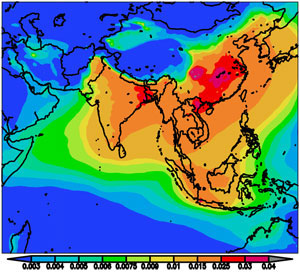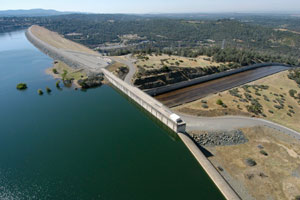Scientists Urge Global Action to Preserve Water Supplies for Billions Worldwide
San Diego, May 18, 2009 -- Melting glaciers, weakening monsoon rains, less mountain snowpack and other effects of a warmer climate will lead to significant disruptions in the supply of water to highly populated regions of the world, especially near the Himalayas in Asia and the Sierra Nevada Mountains of the western United States, according to an international group of scientists who met for three days at the University of California, San Diego.
|
More than two dozen international water experts participating in the “Ice, Snow, and Water: Impacts of Climate Change on California and Himalayan Asia” workshop held at UC San Diego issued a conference declaration May 6 that noted heavy rains in Indian deserts, a recent drought in what is typically one of the wettest place on earth along the foot of the Himalayas, and other extreme weather events in recent decades.
Major rivers in both regions, like China’s Yellow River and the Colorado River in the southwestern United States, routinely fail to reach the ocean now. These extremes are signs of the climate- and societally induced stresses that will be exacerbated in the future under continuing climate changes, threatening massive and progressive disruptions in the availability of drinking water to more than a billion people in the two regions.
The workshop was convened by UC San Diego and the University of Cambridge and coordinated by UC San Diego’s Sustainability Solutions Institute (SSI) and Cambridge Centre for Energy Studies (CCES) based at Judge Business School. The workshop seeks to use the intellectual resources amassed at these and other universities — ranging from climate change research at Scripps to the computing power of the California Institute of Telecommunications and Information Technology (Calit2), and bringing social sciences together with physical and biological sciences – to promote solutions to the world’s most pressing sustainability issues.
“Solutions to immense problems have small beginnings and we began here,” said SSI Senior Strategist Charles Kennel, who served as director of Scripps from 1998 to 2006.
“I continue to be impressed by what a small group of dedicated people can achieve.”
Workshop leaders plan to present the declaration at the 2009 Forum on Science and Technology in Society in Kyoto, Japan, taking place in October. Additionally, the University of Cambridge will continue the discussion of the global water crisis when it hosts in September a companion workshop focused on African water problems.
|
Participants at the workshop held May 4-6 at Scripps Oceanography’s Robert Paine Scripps Forum for Science, Society, and the Environment presented methods used by California researchers to study water supply from the Sierra Nevada, the state’s largest source of water for municipal and agricultural users. Scripps and California state officials project possible 40- to 90-percent declines in Sierra Nevada snowpack by the end of the century.
Chinese experts characterized water quality problems affecting many of the country’s major rivers and lakes and outlined government plans to protect water supply. Representatives from Nepal reported on the dangerous spread of mountain moraines, masses of debris left by retreating glaciers, which have become unstable reservoirs created by rapid glacial melt. Himalayan glaciers supply more than 1 billion people in Asia with drinking water.
Participants also discussed methods by which water resource management solutions that are equitable can be achieved. They concluded in the conference declaration that more resources must be committed to detailed climate modeling and collection of high-resolution data to more rapidly understand threats to water supplies. Declaration co-authors said that water availability can be doubled or tripled in some areas with a combination of conservation, technology, planning, and changed behavior, but that the most effective solutions would likely need to originate at the regional level.
Workshop experts represented the United Nations World Climate Research Program, the Chinese Academy of Sciences, the Indian Space Research Organization, the British Antarctic Survey, the California Department of Water Resources as well as several American universities.
Related Links
Water Shortages Website
The Conference Declaration
Video of the conference declaration public event
Sustainability Solutions Institute (SSI) at UC San Diego
Scripps Homepage
ScrippsNews Home
Media Contacts
UC San Diego media contacts:
Robert Monroe, 858-534-3624 or rmonroe@er.ucsd.edu
Rex Graham, 858-534-5952 or ragraham@ucsd.edu
University of Cambridge media contact:
Tim Holt, 44 (0) 1223 332300 or tim.holt@admin.cam.ac.uk


